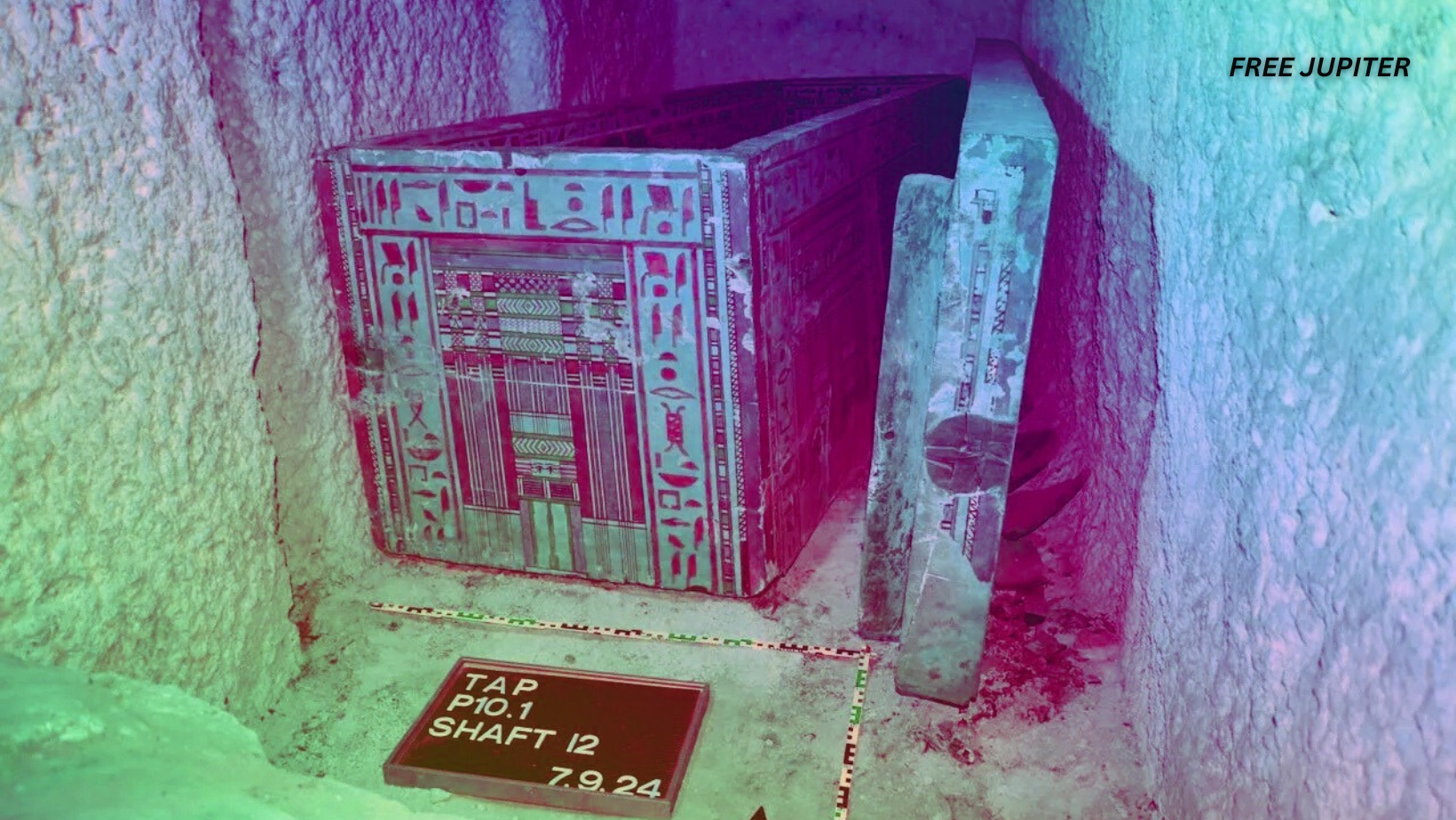Beneath the scorching Egyptian sun, another chapter of ancient history has quietly emerged from the shadows of time. A hidden chamber, sealed for nearly four millennia, has come to light, offering rare glimpses into the sacred rituals and personal life of a powerful woman from the Middle Kingdom of Egypt. Deep within the sprawling necropolis of Asyut, an archaeological mission has uncovered a burial site that had been tucked away behind a stone wall and buried at the bottom of a 14-meter-deep shaft.
This forgotten burial belonged to Idy, a high-ranking priestess of Hathor—goddess of love, fertility, and music. She had once walked the same lands nearly 4,000 years ago, but only now are her final resting place and the sacred items that followed her into the afterlife being revealed.
A Long-Term Excavation Bears Fruit
The necropolis of Asyut, positioned along the fertile banks of the River Nile, has been the focus of intense archaeological interest since the early 2000s. Excavations led by a multinational team had been ongoing at the site since 2003, but it wasn’t until 2022 that the vertical shaft concealing Idy’s burial was identified and excavation efforts began in earnest.
Three separate excavation campaigns were required to reach the bottom of the shaft. The work was painstaking. The descent, carved into limestone bedrock, measured about 14 meters (45 feet) deep. At the shaft’s base, a quarry-stone wall concealed a chamber that had been untouched for thousands of years. Behind it, the burial of Idy waited to be rediscovered.
Nested Coffins Tell a Layered Story
Among the most remarkable elements of this find were two large, ornately decorated coffins. Crafted to fit into each other, they resembled nesting dolls in design. The inner coffin measured 2.3 meters (7.5 feet) in length, while the outer one was slightly longer at 2.62 meters (8.5 feet), according to a statement released by Egypt’s Ministry of Tourism and Antiquities.
Both coffins bore inscriptions and painted decorations that spoke to Idy’s religious role and her journey into the afterlife. The intricate artistry suggested that the woman buried within had held a special place in society—one marked by wealth, spirituality, and influence.
Read more: Archaeologists Are Too Scared To Open The Tomb Of China’s First Emperor
A Priestess Honored in Death
Inscriptions on the wooden surfaces of the coffins identified the deceased as Idy, a priestess of Hathor. She had also been bestowed the prestigious title “Lady of the House,” which in ancient Egyptian culture indicated a woman of noble lineage and high social standing. As a priestess of one of Egypt’s most cherished goddesses, Idy would have participated in significant rituals and temple ceremonies.
Despite the passage of time and the intrusion of grave robbers, many of her burial goods remained undisturbed. Her final resting place revealed not just the materials of status, but symbols of devotion and spiritual preparation for the next world.
Evidence of Robbery—But Much Was Spared
The burial chamber bore signs of ancient looting. It was clear that grave robbers, likely centuries ago, had managed to break into the tomb. Jewelry and items of precious metals were probably taken. However, a considerable portion of the burial goods had been left behind, providing modern archaeologists with invaluable artifacts.
Among the most significant items was a chest containing four canopic jars. These jars were vital to the mummification process, as they were designed to hold and protect the organs removed from the body. Each jar represented one of the Four Sons of Horus—guardian deities associated with different internal organs. Hapy, with the head of a baboon, guarded the lungs. Imsety, depicted with a human head, protected the liver. Duamutef, with the head of a jackal, watched over the stomach. Qebehsenuef, the falcon-headed son, safeguarded the intestines.
These jars, as customary, had been carefully crafted and painted. Their inclusion demonstrated that Idy’s mummification had followed the highest standards of ritual practice in her time.
A Glimpse into the Life—and Death—of Idy
Although partially damaged by looters, Idy’s remains still lay within the inner coffin. Bone fragments and remnants of her garments were found, allowing experts to begin reconstructing her physical profile. Early examinations suggest she had been around 40 years old at the time of her death. Interestingly, signs of a congenital foot deformity were also detected, although no clear cause of death has yet been identified.
The level of care in her burial suggests that she was both loved and respected. Not everyone in Middle Kingdom Egypt received such honors. Idy had clearly belonged to an elite circle, likely tied to the royal court. She had been laid to rest in the tomb of her father, Djefaihapi I, a prominent figure who served under Pharaoh Senusret I.
Read more: A Scientist Says He Has Real Evidence That We Live in a Simulation
Djefaihapi I: A Father of Influence
The burial location offered another clue to Idy’s prestigious life. Djefaihapi I, her father, had held a powerful administrative role during the Middle Kingdom’s 12th Dynasty. As the governor of Asyut and a high official under Pharaoh Senusret I, he would have wielded considerable influence. His tomb, known for its architectural grandeur, had already drawn scholarly interest in previous decades.
That Idy was interred in his tomb confirmed her connection to power. It was not uncommon for prominent family members to share burial complexes, especially in the case of tombs carved into cliffs or accessed via vertical shafts like the one found here.
Spiritual and Ritual Offerings Found Intact
In addition to the coffins and canopic jars, a wide array of funerary items was uncovered. Wooden figurines, commonly used as servant statues or magical protectors in the afterlife, had been carefully placed within the tomb. A ceremonial dagger, likely a symbol of protection and authority, was also discovered.
Pharaonic insignia—symbols associated with the king or divine authority—added further context to the social tier Idy once occupied. Food offerings were found nearby as well, left behind to nourish her spirit on its journey beyond the physical realm.
Each item told its own story, painting a picture of a woman deeply embedded in religious life and surrounded by spiritual safeguards, even in death.
An International Mission of Discovery
This extraordinary find was not the work of a single institution. It was the result of a collaborative effort among universities and researchers from around the world. The Free University of Berlin led the mission alongside Sohag University in Egypt, Kanazawa University in Japan, and the Polish Academy of Sciences.
All discovered artifacts have since been entrusted to Egypt’s Ministry of Tourism and Antiquities, ensuring they will be preserved, studied, and potentially displayed to the public in the future. The joint effort highlights how international cooperation continues to push the boundaries of archaeological understanding in Egypt.
Read more: Historians Shocked As Hidden Artwork Found Underneath Renaissance Painting
What Lies Ahead
Though this discovery is breathtaking in itself, it has opened the door to further questions. Could more chambers exist beneath the necropolis of Asyut? Are other members of Idy’s family interred nearby? The possibility of additional hidden shafts or connected tombs cannot be ruled out. Technology like ground-penetrating radar and thermal imaging may soon be employed to explore deeper without disturbing the ground too heavily.
Archaeologists believe that the tomb complex still holds untapped secrets. Continued excavation will be crucial—not only to uncover more relics but to gain insight into the religious practices and daily lives of Egypt’s ancient elite.
A Legacy Preserved in Stone and Sand
The story of Idy, a woman who lived nearly 4,000 years ago, has been given a voice through this remarkable discovery. Though much of her personal life remains unknown, the items left behind—coffins, jars, offerings, and inscriptions—offer a window into her world.
It is through such finds that modern civilization is reminded of the depth, richness, and complexity of ancient Egyptian culture. As the sands continue to shift and the past is slowly unearthed, the lives of individuals like Idy become more than just footnotes in history—they become human stories that resonate across the ages.










